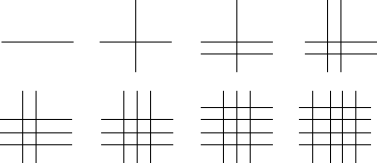Or search by topic
Number and algebra
Geometry and measure
Probability and statistics
Working mathematically
Advanced mathematics
For younger learners
How Many Rectangles?



- Problem
- Solutions
Answer: 42
The sequence of patterns

| Number of lines | New rectangles |
| 1 | 0 |
| 2 | 0 |
| 3 | 0 |
| 4 | 1 |
| 5 | 1 |
| 6 | 2 |
| 7 | 2 |
| 8 | 3 |
9th line adds 3 rectangles (already seen that 9 lines make12 rectangles)
10th, 11th lines +4 each total 12 + 8 = 20
12th, 13th lines +5 each total 20 + 10 = 30
14th, 15th lines +6 each total 30 + 12 = 42
An expression for the number of rectangles
Suppose there are $a$ horizontal and $b$ vertical lines. The grid of rectangles formed is then $a-1$ rectangles high, and $b-1$ rectangles wide. This means there are $(a-1)(b-1)$ rectangles.
If there are a total of $15$ lines, the aim is to make $(a-1)(b-1)$ as large as possible with $a+b=15$.
This can be done by considering the different combinations that add to make $15$:
| $a$ | $b$ | $(a-1)(b-1)$ |
|---|---|---|
| $1$ | $14$ | $0 \times 13 = 0$ |
| $2$ | $13$ | $1 \times 12 = 12$ |
| $3$ | $12$ | $2 \times 11 = 22$ |
| $4$ | $11$ | $3 \times 10 = 30$ |
| $5$ | $10$ | $4 \times 9 = 36$ |
| $6$ | $9$ | $5 \times 8 = 40$ |
| $7$ | $8$ | $6 \times 7 = 42$ |
Therefore, the largest number is $42$ rectangles, formed by having seven lines in one direction and eight in the other.
Alternatively, you can use completing the square to maximise the quantity:
Since $a+b=15$, $(a-1)(b-1) = (a-1)(14-a) = -a^2+15a-14$. Then, by completing the square, this is $-\left(a-\frac{15}{2}\right)^2 + \frac{169}{4}$.
This is maximised when the square is minimised, which occurs when $a=7$ or $a=8$ (since $a$ must be an integer). This gives $6 \times 7 = 42$ rectangles.
You may also like
Consecutive Numbers
An investigation involving adding and subtracting sets of consecutive numbers. Lots to find out, lots to explore.
Tea Cups
Place the 16 different combinations of cup/saucer in this 4 by 4 arrangement so that no row or column contains more than one cup or saucer of the same colour.
Counting on Letters
The letters of the word ABACUS have been arranged in the shape of a triangle. How many different ways can you find to read the word ABACUS from this triangular pattern?

